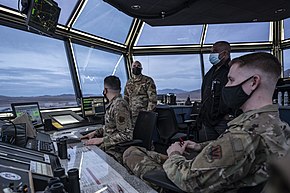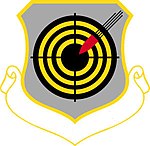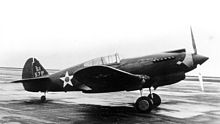57th Operations Group
57th Operations Group
 | |
|---|---|
 Air traffic controllers assigned to the group's 57th Operations Support Squadron monitor traffic at Nellis AFB during a Red Flag exercise in 2021 | |
| Active | 1941 – 1945 1946 – 1953 1961 – 1968 1991 – present |
| Country | |
| Branch | |
| Role | Aggressor training |
| Part of | Air Combat Command |
| Garrison/HQ | Distinguished Unit Citation
French Croix de Guerre with Palm |
| Insignia | |
| 57th Operations Group emblem[a] |  |
| Patch with 57th Fighter Group emblem (Approved 2 February 1950)[2] |  |
The 57th Operations Group (57 OG) is the operational component of the 57th Wing, assigned to the United States Air Force's Air Combat Command. The group is stationed at Nellis Air Force Base, Nevada.
The Group provides direct oversight of the Nellis flying mission through the 57th Operations Support Squadron. They manage the airfield, operate the air traffic control tower, and the Nellis Air Traffic Control Facility providing radar service to local flying operations and the National Airspace System. It is responsible for scheduling, training, life support, weapons, tactics and planning staff functions. In addition to these functions, it also maintains administrative oversight of the 57th ATG staff and the 57th Wing staff.[needs update] The 57th OG also directs execution of two of the world's premier combat training exercises,
Units
As of July 2022[update] the 57th Operations Group is made up of the below units. Unless otherwise stated, the units are based at Nellis AFB, Nevada.[3]
- 6th Combat Training Squadron
- 12th Combat Training Squadron (Fort Irwin, California)
- 57th Information Aggressor Squadron
- 57th Operations Support Squadron
- F-16 Fighting Falcon)
- F-35 Lightning II)
- 414th Combat Training Squadron
- 507th Air Defense Aggressor Squadron
- 548th Combat Training Squadron (Green Flag East) (Fort Johnson, Louisiana)
- 549th Combat Training Squadron (Green Flag West)
History
- See 57th Wing for associated lineage and timeline information.
World War II



The group was first activated as the 57th Pursuit Group in January 1941, flying
The 57th FG was reassigned to the U.S. Army Middle East Force in Egypt. In June 1942 the pilots and 72 new P-40Fs loaded aboard the aircraft carrier
In October 1942, the 57th FG officially began
In an aerial battle over the Gulf of Tunis at Cape Bon in April 1943, the group destroyed approximately 74 of the enemy's transport and fighter aircraft[2] while sending an equal number down to the sea and beaches to escape by crash landing. The 57th lost just six aircraft in this melee. Forever known by the 57th as the 18 April 1943 Goose Shoot – "The Palm Sunday Massacre," it received another DUC[2] and it added four newly created aces. This action broke the German's aerial supply line and they surrendered Tunisia thirty days later.
The 57th supported the British Eighth Army's landing at Termoli and subsequent operations in Italy, being reassigned to Twelfth Air Force in August 1943.[2] It flew dive-bombing, strafing, patrol, and escort missions.
Early in 1944, the group converted to
The group earned a third DUC c. 14 April 1944 for attacks in the
The group remained in northern Italy after the end of the European War, demobilizing throughout the summer of 1945. It was reassigned to the United States in August 1945 and was inactivated at the end of August.[2]
Cold War

The group was reactivated in August 1946 and assigned to
The group was reactivated at
From 1991
On 1 November 1991, the group was redesignated the 57th Operations Group and activated[1] as a result of the 57th Fighter Wing implementing the USAF objective wing organization. The 57 OG was assigned control of the wing's tactical units.
Upon activation, the 57th OG managed Air Force tactical training through Red Flag and Air Warrior exercises.
From 1 July 2005 to 1 March 2018 the group was non-flying as the flying squadrons of the 57th were split off into the new 57th Adversary Tactics Group, which consolidated all Aggressor activities under one group to provide the Combat Air Forces with the opportunity to train against a realistic, fully integrated threat array during large- and small-scale exercises such as Red Flag – Nellis, Red Flag – Alaska, Maple Flag, Green Flag and dissimilar air combat training deployments.
On 2 March 2017 the group activated the
On 31 March 2020, the 57th Adversary Tactics Group merged back into the 57th Operations Group, bringing the 64th Aggressor Squadron and its F-16s with it.[12]
Lineage
- Constituted as the 57th Pursuit Group (Interceptor) on 20 November 1940
- Activated on 15 January 1941
- Redesignated as 57th Fighter Group (Single Engine) on 15 May 1942
- Inactivated on 7 November 1945
- Activated on 15 August 1946
- Redesignated as 57th Fighter-Interceptor Group on 20 January 1950
- Inactivated on 13 April 1953
- Redesignated as 57th Fighter Group (Air Defense) and activated on 24 February 1961 (not organized)
- Organized on 1 April 1961
- Discontinued and inactivated on 30 September 1968
- Redesignated as 57th Fighter Weapons Group on 31 July 1985 (remained inactive)
- Redesignated as 57th Operations Group on 1 November 1991 and activated[1]
Assignments
|
|
Components
|
Operational Squadrons
|
|
Stations
|
|
Aircraft assigned
|
|
Awards
- Distinguished Unit Citation[2]
- North Africa and Sicily, 24 October 1942 – 17 August 1943
- Tunis and Cape Bon Area, 18 April 1943
- Italy, 14 April 1944
- Air Force Outstanding Unit Award[2]
- 1 January 1995 – 31 May 1997
- 1 June 1998 – 31 May 2000
- 1 June 2001 – 31 May 2003
- 1 June 2003 – 31 May 2004
- 1 June 2004 – 31 May 2006
- French Croix de Guerre with Palm, October 1942 – May 1945
- European-African-Middle Eastern Theater
- Campaigns[2]
- Air Combat, EAME Theater
- Egypt-Libya
- Tunisia
- Sicily
- Naples-Anzio
- Rome-Arno
- Southern France
- Northern Apennines
- Po Valley
See also
- Aerospace Defense Command Fighter Squadrons
- SS Sea Owl
References
Footnotes
Citations
- ^ a b c d e f g h i j k Robertson, Patsy (27 July 2009). "Factsheet 57 Operations Group (ACC)". Air Force Historical Research Agency. Archived from the original on 19 January 2018. Retrieved 18 January 2018.
- ^ a b c d e f g h i j k l m n o p q r Maurer, Combat Units, pp. 120–121
- ^ "57th Wing". www.nellis.af.mil. January 2021. Retrieved 17 July 2022.
- ^ YouTube Movie, "Thunderbolt". Retrieved 20 May 2012
- ^ Maurer, Combat Units, 221–222
- ^ Cornett & Johnson, p. 118
- ^ a b "Abstract, History 57 Dispensary Jul–Dec 1962". Air Force History Index. Retrieved 20 May 2012.
- ^ a b "Abstract, History 57 Combat Support Squadron 1958–1968". Air Force History Index. Retrieved 20 May 2012.
- ^ a b Cornett & Johnson, p. 137
- ^ a b Cornett & Johnson, p. 145
- ^ Cornett & Johnson, p. 130
- ^ West, Master Sgt. Heidi (3 April 2020). "57th OG, ATG merge functions, streamlines mission readiness". US Air Force. Archived from the original on 5 April 2020. Retrieved 1 May 2020.
Bibliography
![]() This article incorporates public domain material from the Air Force Historical Research Agency
This article incorporates public domain material from the Air Force Historical Research Agency
- Cornett, Lloyd H; Johnson, Mildred W (1980). A Handbook of Aerospace Defense Organization, 1946 – 1980 (PDF). Peterson AFB, CO: Office of History, Aerospace Defense Center. p. 118. Archived from the original (PDF) on 23 November 2006. Retrieved 20 May 2012.
- Maurer, Maurer, ed. (1983) [1961]. Air Force Combat Units of World War II (PDF) (reprint ed.). Washington, DC: Office of Air Force History. LCCN 61060979.
- Ravenstein, Charles A. (1984). Air Force Combat Wings, Lineage & Honors Histories 1947-1977. Washington, DC: Office of Air Force History. ISBN 0-912799-12-9.\
External links
- Nellis AFB Home Page
- 57th Wing
- Official website of the 57th Fighter Group
- 57th Fighter Group
- 57th Fighter Group Exhibit at the New England Air Museum
- "AF to grow, enhance Nellis group with close air support focus". Air Force News Service. 16 August 2016. Retrieved 19 August 2016.





